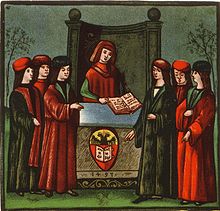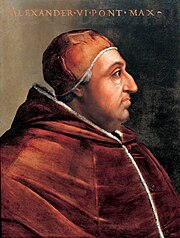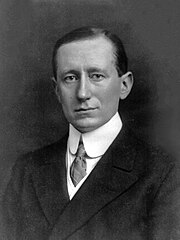| Revision as of 11:55, 13 October 2015 editThomas.W (talk | contribs)Extended confirmed users, Page movers, New page reviewers, Pending changes reviewers, Rollbackers60,972 edits Reverted to revision 685497078 by Thomas.W (talk): Rv; we go by the mainstream definition of university (University#Definition).← Previous edit | Revision as of 14:06, 13 October 2015 edit undo37.245.189.26 (talk) Rv, al-Qarawiyyin is the first and oldest university in the world per the mainstream definition of the word "university". See Cambride dictionaries. Thomas.W should stop citing Wiki because wiki is not reliableNext edit → | ||
| Line 1: | Line 1: | ||
| {{pp-protected|reason=Persistent ]|expiry=12 October 2015|small=yes}} | |||
| {{Infobox university | {{Infobox university | ||
| |name = University of Bologna | |name = University of Bologna | ||
| Line 27: | Line 28: | ||
| }} | }} | ||
| The '''University of Bologna''' ({{lang-it|Università di Bologna}}, '''UNIBO'''), founded in 1088, |
The '''University of Bologna''' ({{lang-it|Università di Bologna}}, '''UNIBO'''), founded in 1088, is sometimes claimed to be the oldest university in Europe. | ||
| It was the first place of study to use the term ''universitas'' for the ]s of students and masters which came to define the institution, located in ], Italy.<ref name=unibo> - Università di Bologna</ref> {{as of|2013}}, the University's crest carries the motto ''] studiorum'' and the date ''A.D. 1088''. The University has about 85,500 students in its 23 ]. It has branch centres in ], ], ], ], ] and ] and a branch center abroad in ]. It also has a school of excellence named ]. The publisher of the University of Bologna is ]. | It was the first place of study to use the term ''universitas'' for the ]s of students and masters which came to define the institution, located in ], Italy.<ref name=unibo> - Università di Bologna</ref> {{as of|2013}}, the University's crest carries the motto ''] studiorum'' and the date ''A.D. 1088''. The University has about 85,500 students in its 23 ]. It has branch centres in ], ], ], ], ] and ] and a branch center abroad in ]. It also has a school of excellence named ]. The publisher of the University of Bologna is ]. | ||
Revision as of 14:06, 13 October 2015
| Università di Bologna | |
 | |
| Latin: Universitas Bononiensis | |
| Motto | Alma mater studiorum (Latin) |
|---|---|
| Motto in English | Nourishing mother of the studies |
| Type | Public |
| Established | 1088, 927 years ago |
| Rector | ] |
| Academic staff | 2,850 |
| Students | 82,363 |
| Undergraduates | 52,787 |
| Postgraduates | 29,576 |
| Location | Bologna, Italy |
| Campus | Urban |
| Sports teams | CUSB |
| Affiliations | Coimbra Group, Utrecht Network, UNIMED |
| Website | www.unibo.it |
The University of Bologna (Template:Lang-it, UNIBO), founded in 1088, is sometimes claimed to be the oldest university in Europe.
It was the first place of study to use the term universitas for the corporations of students and masters which came to define the institution, located in Bologna, Italy. As of 2013, the University's crest carries the motto Alma mater studiorum and the date A.D. 1088. The University has about 85,500 students in its 23 schools. It has branch centres in Imola, Ravenna, Forlì, Sicily, Cesena and Rimini and a branch center abroad in Buenos Aires. It also has a school of excellence named Collegio Superiore di Bologna. The publisher of the University of Bologna is Bononia University Press S.p.A (BUP).
History

The date of its founding is uncertain, but believed by most accounts to have been 1088. The university received a charter from Frederick I Barbarossa in 1158, but in the 19th century, a committee of historians led by Giosuè Carducci traced the founding of the University back to 1088, which would make it the oldest continuously-operating university in the world.
The University arose around mutual aid societies of foreign students called "nations" (as they were grouped by nationality) for protection against city laws which imposed collective punishment on foreigners for the crimes and debts of their countrymen. These students then hired scholars from the city to teach them. In time the various "nations" decided to form a larger association, or universitas—thus, the university. The university grew to have a strong position of collective bargaining with the city, since by then it derived significant revenue through visiting foreign students, who would depart if they were not well treated. The foreign students in Bologna received greater rights, and collective punishment was ended. There was also collective bargaining with the scholars who served as professors at the university. By the initiation or threat of a student strike, the students could enforce their demands as to the content of courses and the pay professors would receive. University professors were hired, fired, and had their pay determined by an elected council of two representatives from every student "nation" which governed the institution, with the most important decisions requiring a majority vote from all the students to ratify. The professors could also be fined if they failed to finish classes on time, or complete course material by the end of the semester. A student committee, the "Denouncers of Professors", kept tabs on them and reported any misbehavior. Professors themselves were not powerless, however, forming a College of Teachers, and securing the rights to set examination fees and degree requirements. Eventually, the city ended this arrangement, paying professors from tax revenues and making it a chartered public university.
The university is historically notable for its teaching of canon and civil law; indeed, it was set up in large part with the aim of studying the Digest, a central text in Roman law, which had been rediscovered in Italy in 1070, and the university was central in the development of medieval Roman law. Until modern times, the only degree granted at that university was the doctorate.
Organization


Higher education processes are being harmonised across the European Community. Nowadays the University offers 101 different "Laurea" or "Laurea breve" first-level degrees (three years of courses), followed by 108 "Laurea specialistica" or "Laurea magistrale" second-level degrees (two years). However, other 11 courses have maintained preceding rules of "Laurea specialistica a ciclo unico" or "Laurea magistrale a ciclo unico", with only one cycle of study of five years, except for medicine and dentistry which requires six years of courses. After the "Laurea" one may attain 1st level Master (one-year diploma, similar to a Postgraduate diploma). After second-level degrees are attained, one may proceed to 2nd level Master, specialisation schools (residency), or doctorates of research (PhD).
The 11 Schools (which replace the preexisting 23 faculties) are:
- School of Agriculture and Veterinary Medicine
- School of Economics, Management and Statistics
- School of Engineering and Architecture
- School of Foreign Languages and Literature, Interpretation and Translation
- School of Law
- School of Letters and Cultural Heritage
- School of Medicine and Surgery
- School of Pharmacy, Biotechnologies and Sport Sciences
- School of Political Sciences
- School of Psychology and Education Sciences
- School of Sciences
The University is structured in 33 departments (there were 66 until 2012), organized by homogeneous research domains that integrate activities related to one or more Faculty. A new department of Latin History was added in 2015.
The 33 departments are:
- Architecture - DA
- Cultural Heritage - DBC
- Chemistry "Giacomo Ciamician" - CHIM
- Industrial Chemistry "Toso Montanari" - CHIMIND
- the Arts - DARvipem
- Pharmacy and Biotechnology - FaBiT
- Classical Philology and Italian Studies - FICLIT
- Philosophy and Communication Studies - FILCOM
- Physics and Astronomy - DIFA
- Computer Science and Engineering - DISI
- Civil, Chemical, Environmental, and Materials Engineering - DICAM
- Electrical, Electronic, and Information Engineering "Guglielmo Marconi" - DEI
- Industrial Engineering - DIN
- Interpreting and Translation - DIT
- Modern Languages, Literatures, and Cultures - LILEC
- Mathematics - MAT
- Experimental Medicine, Diagnostic Medicine and Specialty Medicine - DIMES
- Psychology - PSI
- Agricultural Sciences - DipSA
- Management - DiSA
- Biological, Geological, and Environmental Sciences - BiGeA
- Biomedical and Neuromotor Sciences - DIBINEM
- Education Studies "Giovanni Maria Bertin" - EDU
- Agricultural and Food Sciences - DISTAL
- Economics - DSE
- Legal Studies - DSG
- Medical and Surgical Sciences - DIMEC
- Veterinary Medical Sciences - DIMEVET
- Department for Life Quality Studies - QUVI
- Political and Social Sciences - SPS
- Statistical Sciences "Paolo Fortunati" - STAT
- Sociology and Business Law - SDE
- History and Cultures - DiSCi
Affiliates and other institutions
In the early 1950s, some students of the University of Bologna were among the founders of the review "il Mulino". On April 25, 1951, the first issue of the review was published in Bologna. In a short time, "il Mulino" became one of the most interesting reference points in Italy for the political and cultural debate, and established important editorial relationships in Italy and abroad. Editorial activities evolved along with the review. In 1954, the il Mulino publishing house (Società editrice il Mulino) was founded, which today represents one of the most relevant Italian publishers. In addition to this were initiated research projects (focusing mostly on the educational institutions and the political system in Italy), that eventually led, in 1964, to the establishment of the Istituto Carlo Cattaneo.
Notable people






Alumni
- Irnerius, founder of the School of Glossators
- Henry of Susa (Hostiensis)
- Archbishop of Canterbury Thomas Becket
- Petrarch
- Leon Battista Alberti
- Pope Alexander VI
- Pico della Mirandola
- Erasmus of Rotterdam
- Albrecht Dürer
- Nicolaus Copernicus, formulator of the heliocentric universal model
- Paracelsus, founder of the discipline of toxicology
- Pope Innocent IX
- Ulisse Aldrovandi
- Gabriele Paleotti
- Pope Gregory XIII (Ugo Boncompagni)
- Cardinal Alberto Bolognetti
- Cardinal Paolo Burali d'Arezzo
- Saint Charles Borromeo, archbishop of Milan
- Torquato Tasso
- Gasparo Tagliacozzi, pioneer of plastic and reconstructive surgery
- Pope Gregory XV
- Pietro Mengoli
- Marcello Malpighi
- Carlo Goldoni
- Laura Bassi, the world's first woman to earn a university chair in a scientific field of studies
- Lazzaro Spallanzani
- Luigi Galvani, discoverer of the animal electricity and pioneer of the bioelectromagnetics
- Augusto Righi, pioneer in the study of electromagnetism
- Giovanni Pascoli
- Adamo Boari
- Carlo Severini
- Guglielmo Marconi

- Giacomo Matteotti
- Riccardo Bacchelli
- Enzo Ferrari, founder of the Scuderia Ferrari
- Michelangelo Antonioni
- Pier Paolo Pasolini
- Giorgio Armani, founder of Armani
- Pier Ugo Calzolari
- Piero Gnudi, Minister of Tourism, Sport and Regional Affairs in the Monti Cabinet
- Pierluigi Bersani, former Secretary of the Partito Democratico
- Vasco Rossi
- Lorenzo Sassoli de Bianchi, President of Valsoia
- Mazen Asfour
- Pier Ferdinando Casini, leader of the Union of the Centre
- Carlo Alberto Nucci
- Pierluigi Collina
- Yusuf Mohamed Ismail
- Aldo Costa, Engineering Director of the Mercedes Formula One team
- Juan Fernando López Aguilar, Socialist Member of the European Parliament
- Stefano Domenicali
- Pablo Iglesias Turrión, Secretary-General of Podemos
- Lorenzo Fragola, winner of the eight series of the Italian X Factor
Faculty and staff
See: Serafino Mazzetti, Repertorio di tutti I professori antichi e moderni della famosa Università...di Bologna (Bologna 1848).
- 11th century
- 12th century
- 13th century
- Rambertino Buvalelli
- Paul, Dominican martyr
- Bettisia Gozzadini
- William of Saliceto
- Sylvester Gozzolini
- Guido Guinizelli
- Benvenutus Scotivoli
- Henry of Susa (Hostiensis)
- 14th century
- 15th century
- 16th century
- 17th century
- 18th century
- 19th century
- 20th century
- 21st century
World rankings
| ARWU (2015, national) | 6-8 |
|---|---|
| ARWU (2015, world) | 201-300 |
| QS (2014/15, national) | 1 |
| QS (2014/15, world) | 182 |
| THE (2014/15, national) | 8-9 |
| THE (2014/15, world) | 276-300 |
| CENSIS-La Repubblica (state mega-universities) (2014, national) | 1 |
| Il Sole 24 Ore (state universities) (2015, national) | 4 |
In 2010 QS World University Rankings ranked the University of Bologna 176th in the world, and 32nd in the world for Law. On the 2009 THE–QS World University Rankings list (in 2010 Times Higher Education World University Rankings and QS World University Rankings parted ways to produce separate rankings), the University of Bologna was ranked inside the top 200 for the third consecutive year. In 2014, the Italian newspaper La Repubblica, in collaboration with CENSIS, has awarded the University of Bologna the first place in its academic ranking of Italian universities for the fifth time in a row. An overview of the THE-QS Rankings up to 2013:
| Year | Rank (Change) |
|---|---|
| 2005 | 159 |
| 2006 | 207 ( |
| 2007 | 173 ( |
| 2008 | 192 ( |
| 2009 | 174 ( |
| 2010 | 176 ( |
| 2011 | 183 ( |
| 2012 | 194 ( |
| 2013 | 188 ( |
| 2014 | 182 ( |
Points of interest
- Orto Botanico dell'Università di Bologna
- L'Orto Agrario "Filippo Re" (in Italian) (Translate to English: Google, Bing, Yandex)
See also
- Collegio Superiore di Bologna (school of excellence of the University of Bologna)
- Coimbra Group (a network of leading European universities)
- Utrecht Network
- Bologna declaration
- Bologna process
- List of Italian universities
- Medieval university
- Bologna
- List of medieval universities
Notes and references
- ^ Nove secoli di storia - Università di Bologna
- Top Universities World University Rankings Retrieved 2010-1-6
- Our History - Università di Bologna
- Paul L. Gaston (2010). The Challenge of Bologna. p. 18. ISBN 1-57922-366-4.
{{cite book}}: External link in|title= - A University Built by the Invisible Hand, by Roderick T. Long. This article was published in the Spring 1994 issue of Formulations, by the Free Nation Foundation.
- Berman, Law and Revolution, ch. 3; Stein, Roman Law in European History, part 3.
- See Corpus Juris Civilis: Recovery in the West
- List of the Departments of the University of Bologna
- ^ "Academic Ranking of World Universities 2015". Shanghai Ranking Consultancy. Retrieved 15 August 2015.
- ^ "QS World University Rankings 2014/15". Quacquarelli Symonds. Retrieved 19 September 2014.
- "Top European Universities 2014-15". Times Higher Education. Retrieved 2 October 2014.
- "THE Top 400 Universities 2014-15". THE. Retrieved 2 October 2014.
- "Classifica completa Censis delle Università italiane 2014/2015". Classifica completa Censis delle Università italiane 2014/2015 (in Italian). Retrieved 7 August 2015.
- "La classifica delle migliori università italiane - Edizione 2015". Il Sole 24 Ore (in Italian). Retrieved 7 August 2015.
- "QS World University Rankings 2010 Results".
- Alma Mater superstar: stacca le concorrenti tra le mega università, by Ilaria Venturi.
External links
- University of Bologna Website Template:En icon
- University of Bologna Website (in Italian) (Translate to English: Google, Bing, Yandex) (also has a Chinese version)
- University of Bologna in Buenos Aires (in Spanish) (Translate to English: Google, Bing, Yandex)
- Beautiful universities around the world
| Mediterranean Universities Union (UNIMED) | |||||||||||||||||||||||||
|---|---|---|---|---|---|---|---|---|---|---|---|---|---|---|---|---|---|---|---|---|---|---|---|---|---|
| |||||||||||||||||||||||||
| |||||||||||||||||||||||||
| |||||||||||||||||||||||||
| International Forum of Public Universities | |
|---|---|
| Europe | |
| Americas | |
| Asia | |
| Africa | |
44°29′38″N 11°20′34″E / 44.49389°N 11.34278°E / 44.49389; 11.34278
Categories: